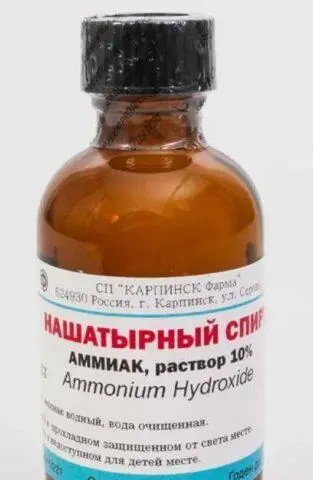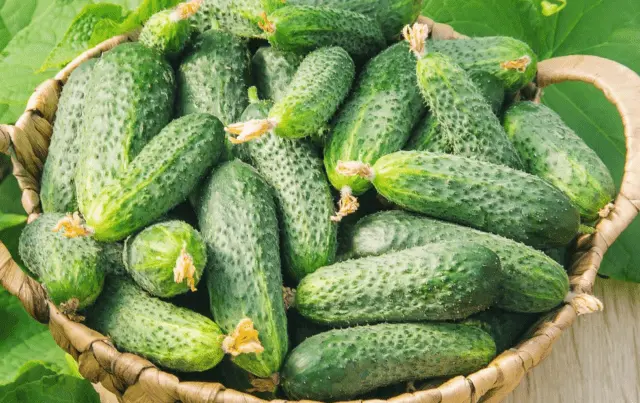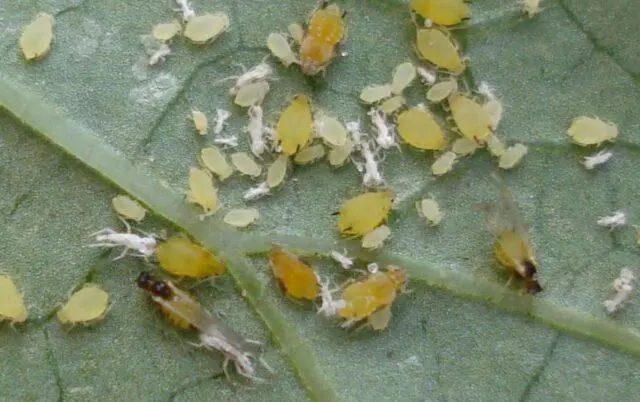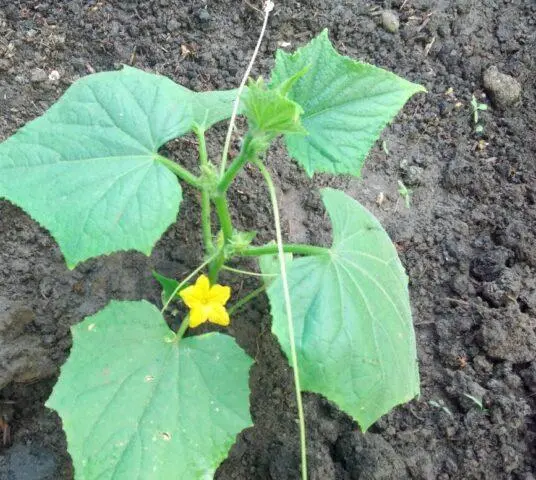Contents
- Why water cucumbers with ammonia
- Dosage of ammonia for cucumbers
- Methods for feeding cucumbers with ammonia
- Ammonia for cucumbers from pests and diseases
- You can water cucumbers with ammonia during flowering and fruiting.
- Features of processing cucumbers with ammonia in the greenhouse
- Safety Precautions
- Conclusion
- Reviews on the use of ammonia for cucumbers
Ammonia for cucumbers serves as a natural source of nitrogen, thanks to which the bushes grow quickly, grow stronger and gain green mass. Ammonium chloride is used in the early stages of the growing season. After the appearance of the first fruits, it is not used.
Why water cucumbers with ammonia
Ammonia performs three main functions:
- Serves as a source of nitrogen (fertilizer).
- Destroys fungi and bacteria.
- The pungent odor repels insects and other pests.
Ammonia is also used to obtain a good harvest of cucumbers. Due to the fact that the substance contains a large amount of nitrogen, systematic treatments lead to a rapid growth of the green mass of the plant. As a result, the bushes become strong and healthy, they better withstand adverse weather, pests and diseases.
Dosage of ammonia for cucumbers
Ammonia is an aqueous solution of ammonia (NH3). It is sold in a pharmacy in dark glass bottles or other containers. In most cases, the solution has a strength of 10%. This is a high concentration, so the liquid must be diluted to process cucumbers.
The dosage depends on the type of treatment (root, foliar top dressing), as well as on the stage of plant development. The table shows the main proportions for feeding cucumbers with ammonia.
A method of processing | Stage of development | Consumption, ml per 10 l |
Spraying | Seedlings with 2-3 or more leaves | 20 |
2 weeks after transplanting into the ground | ||
The beginning of the appearance of flowers | ||
Watering | grown seedlings | 50 |
The main wave of flowering | 90 | |
Mass formation of cucumbers | 45 | |
If there are signs of nitrogen deficiency* | 12 | |
To prevent deficiency | 50 |
* Symptoms of nitrogen deficiency in cucumbers:
- shoots become thin;
- inflorescences are very small;
- the color of the tops is pale green;
- the lower leaf plates begin to turn yellow;
- short internodes;
- obvious stunting.
Preparing the solution is quite simple. Since ammonia is already dissolved, water can be taken at any temperature. The sequence of actions is as follows:
- Take a bucket of water 10 l
- Wear a mask to avoid inhaling fumes.
- Measure the required amount of ammonia.
- Pour it into a bucket.
- Stir well.
- Start watering cucumbers or pour into a spray bottle.

The standard concentration of pharmaceutical ammonia is 10%
When watering cucumbers with ammonia, the consumption rate is up to 1 liter per bush. If top dressing is foliar, it is necessary to carry out a total spraying of the entire aerial part of the plant (leaves, stems).
Store the composition no more than 1-2 days. If there is a surplus, you can simply water other plantings, the soil in or near the greenhouse. Thanks to this, the soil will receive additional nitrogen replenishment.
Methods for feeding cucumbers with ammonia
Ammonia is given to cucumbers in two main ways – root (watering) and foliar (total spraying). If there are not very many plantings, you can moisten gauze or cotton wool and wipe the leaves. This procedure will take a little longer.
How to water cucumbers with ammonia under the root
Root top dressing is given to cucumbers even at the seedling stage, when it grows up and gets stronger (5-7 leaves or more). Fertilizer is also given in the following cases:
- mass flowering;
- the beginning of the formation of fruits;
- clear signs of nitrogen deficiency (at any stage).
Before watering, prepare a solution of the desired concentration. Pour under the root (1 liter per well).
Foliar top dressing
Ammonia is also used for foliar feeding of cucumbers in the open field and in the greenhouse. Spraying is done in the following cases:
- newly emerged shoots of seedlings (at least two true leaves);
- 15 days after transplanting cucumbers into a greenhouse or soil;
- the formation of the first flowers.
Pre-measure the required volume of ammonia and dissolve it in water, then proceed to total spraying. You can also wipe the leaves with a cloth soaked in the solution (this is especially effective in case of severe nitrogen deficiency).
Spraying is done in the early morning or late evening. If the bushes grow in an open garden, work is planned only for dry, calm weather.
Ammonia for cucumbers from pests and diseases
To get a good harvest of large cucumbers, as in the photo, it is important to feed ammonia in a timely manner. The tool is used not only for treatment, but also as a preventive measure.

Ammonia not only increases productivity, but also protects cucumbers from diseases and pests.
From diseases
When growing seedlings in open ground and in a greenhouse, the culture may suffer from fungal, bacterial diseases and other infections. Therefore, as a preventive measure, it is recommended:
- The day before planting, water the soil for seedlings with ammonia (10 ml per 10 l).
- A day before the transfer of cucumber seedlings to the ground, moisten the previously dug holes with a solution of the same concentration.
- Treat with ammonia a few days after transplanting seedlings.
If signs of powdery mildew, cladosporiosis, gray rot or other fungal infections are found, they act as follows:
- Carefully inspect the planting of cucumbers and remove all affected leaves. If necessary, heavily affected plants are planted.
- A concentrated liquid is obtained (50 ml of ammonia in 10 liters of water).
- Pour into a sprayer and carry out total processing. Moreover, it is necessary to spray not only the affected plants, but also healthy ones, since they can also be infected.
- After 10-15 days, the cucumbers are re-treated with ammonia. As a rule, this is enough, but sometimes a third procedure has to be done to completely destroy the fungi.
From pests
Chemicals help to cope with insects. Very often, ammonia is used to spray cucumbers from pests:
- aphid;
- spider mite;
- whiteflies;
- bears;
- slippery;
- wireworms;
- ants

Ammonia relieves planting from pests
For the processing of cucumbers, concentrated ammonia is prepared. Moreover, for a better effect, other components can be added to the composition. Below are popular recipes (calculations for 10 liters):
- 50-60 ml of ammonia is mixed with 150 g of pre-obtained shavings of household or tar soap. Due to the latter, an alkaline environment is created that destroys pests. In addition, soapy water is better retained on the leaves and stems of cucumbers, which is especially important in rainy and windy weather.
- 10 ml of ammonia is dissolved in water and lashes of cucumbers are watered. The concentration is low, but this liquid helps in the fight against wireworm.
- They take cotton wool and moisten it in a solution of pharmaceutical ammonia. They put it next to the minks in which moles live or not far from cucumber beds (to protect against slugs).
- If an anthill appears on the site, it must be destroyed. Ants promote the reproduction of aphids. To combat them, take several bottles of ammonia (total volume 100 ml per 1 liter of water) and fill the anthill with the resulting liquid. If necessary, you can additionally walk with boiling water.
You can water cucumbers with ammonia during flowering and fruiting.
Ammonia is a source of nitrogen for cucumbers. It contributes to the rapid set of green mass, the growth of shoots and leaves. This is a very useful top dressing at the initial stages of plant development. But during flowering and fruiting, its introduction is minimized – it is enough to make one watering. Foliar treatments are carried out only for the destruction of pests or the treatment of diseases.
In some cases, fertilizing with ammonia is completely excluded. After the fruits began to actively form, cucumbers no longer need a large amount of nitrogen. If the fruits are small, and the shoots, on the contrary, are tall and large (fatten), the introduction of ammonia is also not allowed.

Ammonium chloride can be used during flowering, but in moderation
Features of processing cucumbers with ammonia in the greenhouse
Ammonia is also used to feed cucumbers in a greenhouse. The timing, dosage and frequency of treatments are exactly the same. But there are also a few features:
- The substance is odorous, therefore, during spraying, watering, the doors of the greenhouse must be opened wide.
- Since watering leads to an increase in air humidity, the greenhouse should be ventilated in the heat.
- If the soil is infertile, then in the spring, when digging, it can be watered with a weak (10 ml per 10 l) solution of ammonia.
Safety Precautions
Ammonia is a substance with a pungent odor. Inhalation of its vapors can lead to headaches, dizziness and other unpleasant consequences. Therefore, when processing and preparing the solution, several precautions must be observed:
- work in a mask (especially in a greenhouse);
- exclude access to children;
- prevent contact with eyes (if necessary, rinse under low pressure of water);
- do not prepare the composition for long-term storage.
Conclusion
Ammonia for cucumbers is the most inexpensive remedy that is used as a nitrogen supplement, as well as for treatment against pests and diseases. For effective use, the prescribed concentrations must be observed. As soon as the first fruits appear, it is better to stop fertilizing with ammonia.









